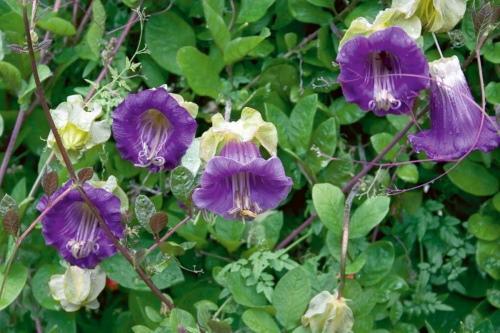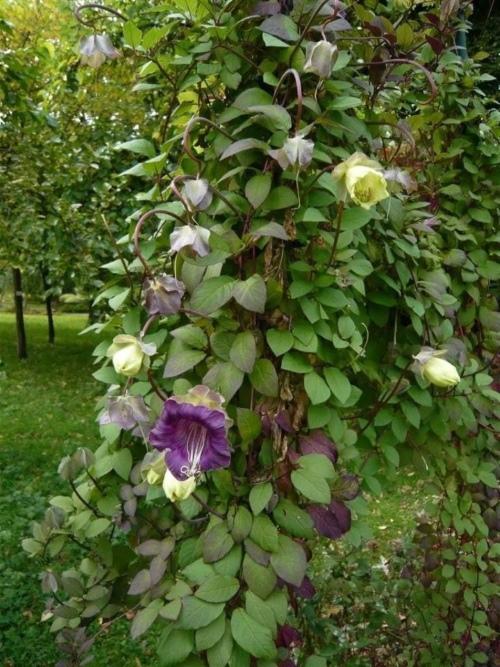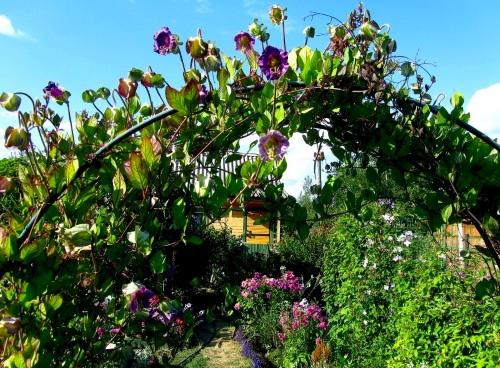Kobeya purple is an ideal vine that grows quickly and blooms gorgeous
 Fans of weaving lianas have long known the purple kobei. This ornamental shrub will delight not only with long shoots that quickly braid the support. It acquires special charm during flowering, when rounded bells bloom against the background of emerald foliage. Moreover, the kobea blooms all summer, until the very frosts, and the liana is not at all capricious in leaving. Sun, moisture, adequate support and a little extra nourishment - that's all she needs.
Fans of weaving lianas have long known the purple kobei. This ornamental shrub will delight not only with long shoots that quickly braid the support. It acquires special charm during flowering, when rounded bells bloom against the background of emerald foliage. Moreover, the kobea blooms all summer, until the very frosts, and the liana is not at all capricious in leaving. Sun, moisture, adequate support and a little extra nourishment - that's all she needs.
What does a plant look like

The decorativeness of the kobei is fully manifested with the arrival of July, when many buds bloom among the foliage. When closed, they are yellow-green, and when fully bloom, they turn purple. The flowers grow mainly one at a time, in the form of an even rounded bell. The protruding yellowish stamens give them special elegance. The diameter of each bell is about 8 cm. Close up, you can feel a light honey aroma emanating from them with an unobtrusive musky note. Flowering lasts until frost.
In our conditions, purple, and other species of kobei, are grown in the open field as annuals... They will not survive the winter in the garden, so they will have to sow seeds every year. However, you can go the other way: in the fall, cut off the aerial part and transplant the bush into a pot. After overwintering in the cellar, in the spring the kobea will again begin to grow shoots.
Kobei purple - features of growing blooming liana
 Gardeners who decide to plant a vine most often plant it by seed. But there are some nuances here:
Gardeners who decide to plant a vine most often plant it by seed. But there are some nuances here:
- Collecting your own seeds will not work, even if you already have a bush. In our climate, they do not have time to mature.
- Not all seeds will sprout due to the dense shell.
However, this does not stop kobei lovers. You can buy seeds at any store, especially on the Internet. And the soaking procedure will help to increase germination. After a couple of days, the shell becomes limp and turns into mucus. After washing it off, you can plant seeds.
 It is better to grow by seedling method so that the bush blooms earlier. Seeds need to be sown in early March, it is possible in a general container. Grown up seedlings dive into separate pots for growing. Seedlings can be transplanted to a permanent place in early May, when the frosts pass.
It is better to grow by seedling method so that the bush blooms earlier. Seeds need to be sown in early March, it is possible in a general container. Grown up seedlings dive into separate pots for growing. Seedlings can be transplanted to a permanent place in early May, when the frosts pass.
There is another way to breed kobei. To do this, you need to root cuttings taken in the spring from a bush that has wintered indoors.
In the garden for the kobei, you should choose a well-lit area; in the shade, it does not grow well.Care consists in regular watering and feeding, which contributes to the rapid growth of the vine.